Introduction
A new set of mid-21st-century (2041-2060) high-resolution climate projections for Ireland have been published, taking a multi-model ensemble approach in order to better quantify the inherent uncertainty associated with such projections (Nolan and Flanagan, 2020). This research was carried out by the Irish Centre for High-End Computing (ICHEC) on behalf of the Environmental Protection Agency (EPA) and supported by Met Éireann and the Marine Institute. A general overview of the report is presented here, with the full report available to download at: http://epa.ie/pubs/reports/research/climate/researchreport339/
Overview
Climate change represents an urgent and potentially irreversible threat to human societies globally, with increasing atmospheric greenhouse gas concentrations driving changes in all aspects of the climate system, including increases in the frequency and intensity of extreme weather events (Allen et al., 2018). Accurate climate projections are a key scientific input for national policymakers when planning for, and adapting to, such challenges. Such climate projections are produced using climate models, which scientists have developed over recent decades to simulate Earth’s past, present, and future climate.
Global Climate Models (GCMs) are used to model the global impacts on Earth’s climate of increasing greenhouse gas concentrations in the atmosphere. Due to computational constraints, long climate simulations using GCMs are currently feasible only with horizontal resolutions of ~50km or coarser (Nolan and Flanagan, 2020). This resolution is sufficient to obtain an accurate global picture of changes in Earth’s climate; however, it is insufficient to capture key small-scale atmospheric features on the scale of 1-10km, such as local convection and wind gusts. To adequately simulate such features, Regional Climate Models (RCMs) are needed.
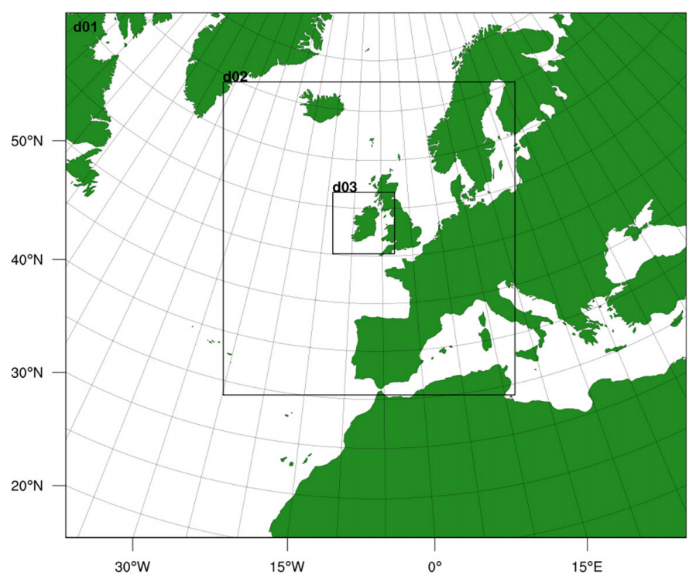
Figure 1: The COSMO4-CLM model domains (Nolan P., Flanagan J., 2020, their Figure 1.1). The d01, d02 and d03 domains have 50-, 18- and 4-km grid spacings, respectively.
Using the output of GCMs as input, RCMs model regional climates at higher spatial resolutions, a process known as dynamical downscaling. Such an approach enables more precise modelling of a number of key climate variables, including: precipitation; near-surface temperature; and the number and intensity of low-pressure systems (Zappa et al., 2013). The added value of RCMs in the modelling of low-pressure systems is of particular importance for Ireland, as they are the primary driver of precipitation and wind affecting the country.
While dynamically downscaling GCM output using an RCM allows for more precise modelling, a climate model is nevertheless, by its very nature, an approximation of the full complexity of the climate system. In this study, a number of CMIP5 (Coupled Model Intercomparison Project – Phase 5, Taylor et al., 2012) GCMs were first run at a spatial resolution of ~125km or coarser and subsequently downscaled to a spatial resolution of ~4km over Ireland using three high-resolution RCMs; this allowed for partially quantifying the associated model uncertainty.
The GCMs used in this study were: HadGEM2-ES from the UK Met Office (W.J. Collins et al., 2011); four realisations of the EC-Earth model (Hazeleger et al., 2011); CNRM-CM5 (Voldoire et al., 2013); MIROC5 (Watanabe et al., 2010); and the MPI-ESM-LR Earth System Model (Giorgetta et al., 2013). These GCMs were then downscaled using versions 4 and 5 of the COSMO-CLM RCM (Doms and Schättler, 2002), along with the WRF RCM (Skamarock et al., 2008).
The resulting multi-model ensemble was first run for a reference period 1981-2000. Gridded datasets of observations at 1-km resolution covering Ireland (Walsh, 2012) for the period 1981–2000 were obtained from Met Éireann and used to validate the modelled reference period. Once validated, a statistical analysis of the resulting ensemble of downscaled projections allowed for the uncertainty in these projections to be partially quantified.
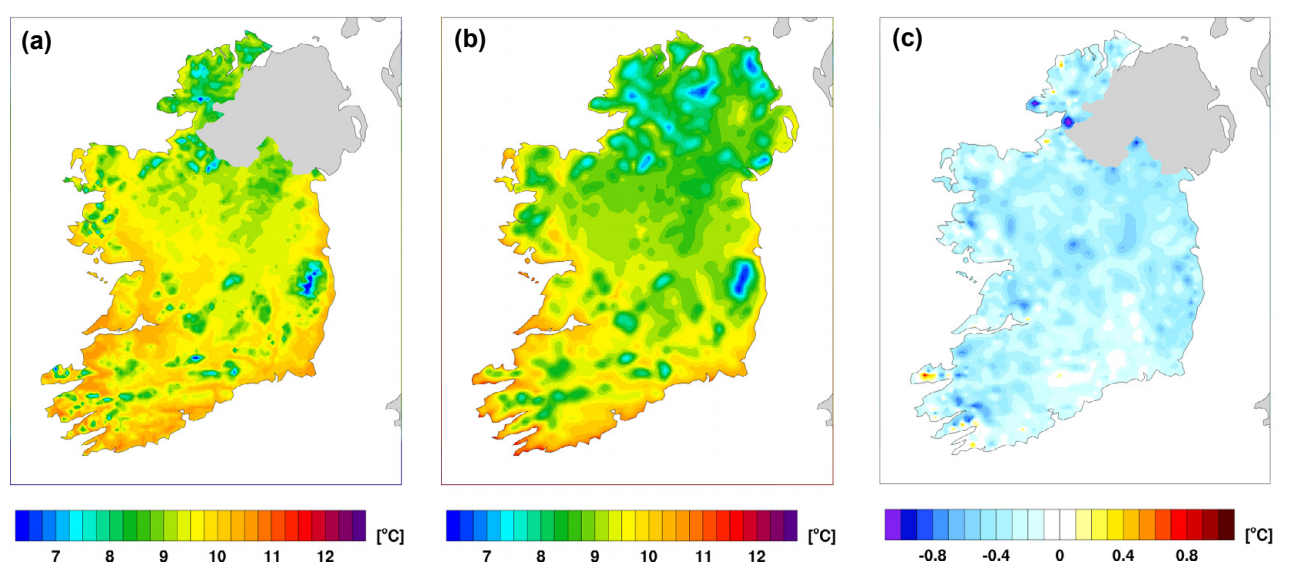
Figure 2. Mean annual 2-m temperature for 1981–2000 (Nolan P., Flanagan J, 2020, their Figure 2.2): (a) observations, (b) COSMO5-CLM-ERA-Interim 4-km data and (c) COSMO5-CLM-ERA-Interim bias.
Future greenhouse gas concentrations in the atmosphere are also uncertain. To model possible future climate change, varying greenhouse gas concentrations over time are needed as a GCM input. Such concentration trajectories are known as Representative Concentration Pathways (RCPs), with four main RCPs considered by the IPCC: RCP2.6, RCP4.5, RCP6 and RCP8.5 (IPCC, 2013a+b).
It is important to note that these trajectories do not constitute predictions of future concentration values as such, but rather plausible potential future values. For this study two RCPs were chosen, RCP4.5 and RCP8.5. RCP4.5 is considered an intermediate scenario, while RCP8.5 is currently considered to be representative of a potential worst-case scenario. In choosing these two RCPs, this study allows downstream users of the resulting climate projection data to assess potential future impacts as a function of varying greenhouse gas concentrations.
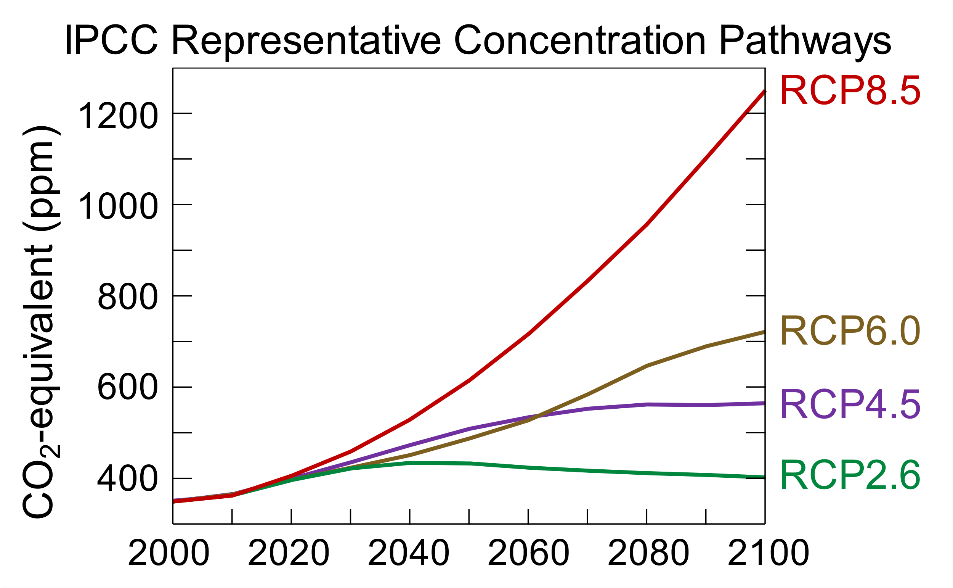
Figure 3: All forcing agents’ atmospheric CO2-equivalent concentrations (in parts-per-million-by-volume (ppmv)) according to the four RCPs used by the fifth IPCC Assessment Report (Efbrazil, 2020)
Results
The results of the climate modelling reported are in broad agreement with numerous previous studies (Nolan 2015, Nolan et al 2017). In summary, for Ireland it was found that by mid-century (2041-2060):
- temperatures are projected to increase by 1–1.6°C compared with the reference period (1981–2000), with an east-west gradient and with the largest increases in the east;
- warming will be enhanced at the extremes, with summer daytime and winter night-time temperatures projected to increase by 1–2.4°C;
- the number of frost and ice days will decrease by approximately 50%;
- summer heatwave events are expected to occur more frequently;
- precipitation is expected to become more variable, with substantial projected increases in the occurrence of both dry periods and heavy precipitation events;
- snowfall is projected to decrease substantially across the country;
- specific humidity is projected to increase substantially, while relative humidity is projected to increase slightly for all seasons except summer;
- mean 10-m wind speeds are projected to decrease for all seasons;
- an overall reduction of ~10% in the numbers of storms affecting Ireland, with an eastward extension of the more severe wind storms over Ireland and the UK;
- an increase in the length of the growing season of between 12% and 16%;
- the energy content of the 120-m wind is projected to decrease, while a small decrease in solar photovoltaic (PV) power is projected.
Figures 4 and 5 show mid-century projections for 2-m temperature changes and mean precipitation changes, respectively. For more detailed results, the reader is referred to the report (Nolan and Flanagan, 2020), which also presents additional projections of climate fields and derived variables that are of importance to sectors including agriculture, health, energy, biodiversity, and transport.
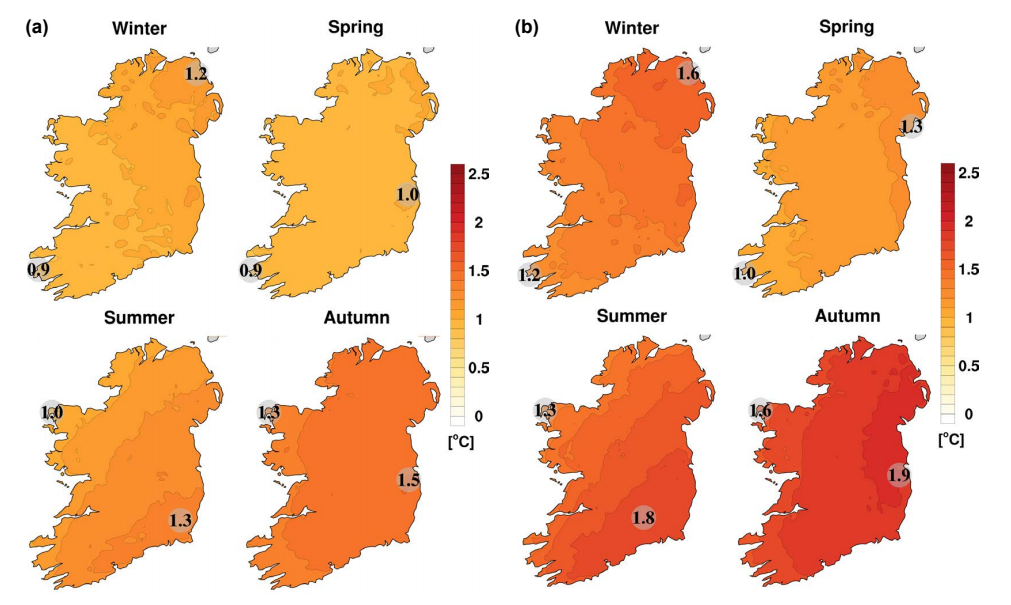
Figure 4, (Nolan and Flanagan, 2020, their Figure 3.2): Mid-century seasonal projections of mean 2-m temperature change for the (a) RCP4.5 and (b) RCP8.5 scenarios. In each case, the future period, 2041–2060, is compared with the past period, 1981–2000. The numbers included on each plot are the minimum and maximum projected changes.
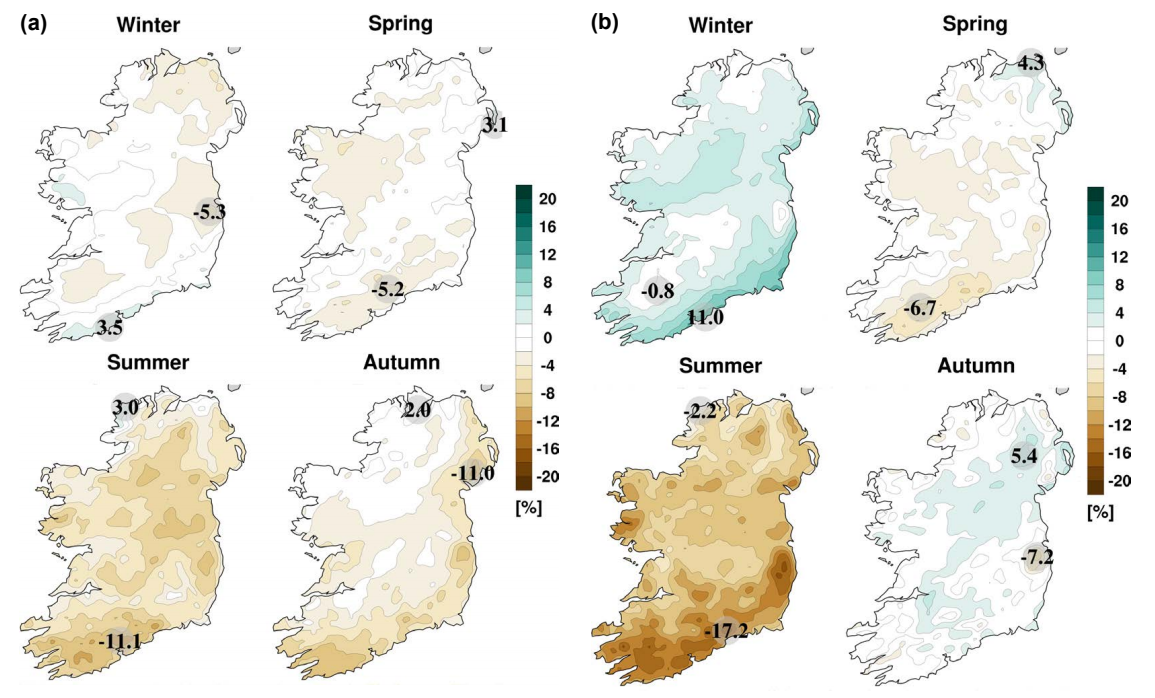
Figure 5, (Nolan and Flanagan, 2020, their Figure 3.17): Mid-century seasonal projections of mean precipitation (%) for the (a) RCP4.5 and (b) RCP8.5 scenarios. In each case, the future period, 2041–2060, is compared with the past period, 1981–2000. The numbers included on each plot are the minimum and maximum projected changes, displayed at their locations.
Future Work
The study presented here focused on downscaling the output from a number of CMIP5 GCMs. Since this work was completed, simulations using the next generation CMIP6 GCMs (Eyring et al, 2016) have recently been completed. Downscaling the output from an ensemble of such CMIP6 GCMs for Ireland has already begun (http://www.epa.ie/pubs/reports/research/tech/researchreport310/). This new work focuses on downscaling the Scenario Model Intercomparison Project (ScenarioMIP) “tier 1” Shared Socioeconomic Pathways (SSPs), (Riahi et al., 2017) output, and will also extend the future period considered to include the full 21st-century.
In addition, Met Éireann is also coordinating a number of activities in the area of future climate research, including the standardisation of national climate projections for Ireland in collaboration with climate research groups across the country. Met Éireann is also currently working on developing a suite of climate services to meet adaptation requirements for a range of sectors across Irish society.
References
Allen, M.R., O.P. Dube, W. Solecki, F. Aragón-Durand, W. Cramer, S. Humphreys, M. Kainuma, J. Kala, N. Mahowald, Y. Mulugetta, R. Perez, M. Wairiu, and K. Zickfeld, 2018: Framing and Context. In: Global Warming of 1.5°C. An IPCC Special Report on the impacts of global warming of 1.5°C
Collins, W.J., Bellouin, N., Doutriaux-Boucher, M., Gedney, N., Halloran, P., Hinton, T., et al., 2011. Development and evaluation of an Earth-system model: HadGEM2. Geo. Model Dev. 4: 1051–1075.
Doms, G. and Schättler, U., 2002. A Description of the Nonhydrostatic Regional Model LM. Part I: Dynamics and Numerics. Deutscher Wetterdienst, Offenbach, Germany
Efbrazil – Own work, CC BY-SA 4.0, https://commons.wikimedia.org/w/index.php?curid=87801257
Eyring, V., Bony, S., Meehl, G. A., Senior, C. A., Stevens, B., Stouffer, R. J., and Taylor, K. E.: Overview of the Coupled Model Intercomparison Project Phase 6 (CMIP6) experimental design and organization, Geosci. Model Dev., 9, 1937-1958, doi:10.5194/gmd-9-1937-2016, 2016.
Giorgetta, M.A., Jungclaus, J., Reick, C.H., Legutke, S., Bader, J., Böttinger, M., Brovkin, V., Crueger, T., Esch, M., Fieg, K. and Glushak, K., 2013. Climate and carbon cycle changes from 1850 to 2100 in MPI-ESM simulations for the Coupled Model Intercomparison Project phase 5. Journal of Advances in Modeling Earth Systems 5(3): 572–597.
Hazeleger, W., X. Wang, C. Severijns, S. Ştefănescu, R. Bintanja, A. Sterl, K. Wyser, T. Semmler, S. Yang, B. van den Hurk, T. van Noije, E. van der Linden, and K. van den Wiel (2012), EC-Earth V2: description and validation of a new seamless Earth system prediction model. Clim. Dyn., 39, 2611-2629
IPCC (Intergovernmental Panel on Climate Change), 2013a. Climate Change 2013: The Physical Science Basis. Contribution of Working Group I to the Fifth Assessment Report of the Intergovernmental Panel on Climate Change. Stocker, T.F., Qin, D., Plattner, G.-K., Tignor, M., Allen, S.K., Boschung, J., Nauels, A., Xia, Y., Bex, V. and Midgley, P.M. (eds). Cambridge University Press, Cambridge, UK.
IPCC (Intergovernmental Panel on Climate Change), 2013b. Near-term climate change: projections and predictability. In Stocker, T.F., Qin, D., Plattner, G.-K., Tignor, M., Allen, S.K., Boschung, J., Nauels, A., Xia, Y., Bex, V. and Midgley, P.M. (eds), Climate Change 2013: The Physical Science Basis. Contribution of Working Group I to the Fifth Assessment Report of the Intergovernmental Panel on Climate Change. Cambridge University Press: Cambridge, UK
Nolan, P., O’Sullivan, J., & McGrath, R. (2017). Impacts of climate change on mid‐twenty‐first‐century rainfall in Ireland: a high‐resolution regional climate model ensemble approach. Int. Jour. of Clim.
Nolan, P., 2015. Ensemble of Regional Climate Model Projections for Ireland. Environmental Protection Agency, Johnstown Castle, Ireland. Nolan P. and McKinstry, A., 2020.
Nolan P. and McKinstry, A., 2020. EC-Earth Global Climate Simulations: Ireland’s Contributions to CMIP6. Environmental Protection Agency, Johnstown Castle, Ireland. Available online: http://www.epa.ie/pubs/ reports/research/tech/researchreport310/
Nolan, P., Flanagan, J. (2020). High-resolution Climate Projections for Ireland – A Multimodel Ensemble Approach. EPA report 339, http://epa.ie/pubs/reports/research/climate/researchreport339/
Riahi, K., van Vuuren, D.P., Kriegler, E., Edmonds, J., O’Neill, B.C., Fujimori, S., et al., 2017. The shared socioeconomic pathways and their energy, land use, and greenhouse gas emissions implications: an overview. Global Environmental Change 42: 153–168
Skamarock, W.C., Klemp, J.B., Dudhia, J., Gill, D.O., Barker, D.M., Duda, M.G., Huang, X.Y., Wang, W. and Powers, J.G., 2008. A Description of the Advanced Research WRF Version 3.
Taylor, K.E., Stouffer, R.J. and Meehl, G.A., 2012. An overview of CMIP5 and the experiment design. Bulletin of the American Meteorological Society 93(4): 485–498.
Voldoire, A., Sanchez-Gomez, E., y Mélia, D.S., Decharme, B., Cassou, C., Sénési, S., Valcke, S., Beau, I., Alias, A., Chevallier, M. and Déqué, M., 2013. The CNRM-CM5.1 global climate model: description and basic evaluation. Climate Dynamics 40(9–10): 2091–2121
Walsh, S., 2012. A Summary of Climate Averages for Ireland 1981–2010. Climatological Note No14. Met Éireann, Dublin. Available online: www.met.ie/climateireland/SummaryClimAvgs.pdf
Watanabe, M., Suzuki, T., O’ishi, R., Komuro, Y., Watanabe, S., Emori, S., et al., 2010. Improved climate simulation by MIROC5: mean states, variability, and climate sensitivity. Jour. of Clim. 23: 6312–6335.
Zappa, G., Shaffrey, L.C., Hodges, K.I., Sansom, P.G. and Stephenson, D.B., 2013. A multimodel assessment of future projections of North Atlantic and European extratropical cyclones in the CMIP5 climate models. Journal of Climate 26(16): 5846–5862.